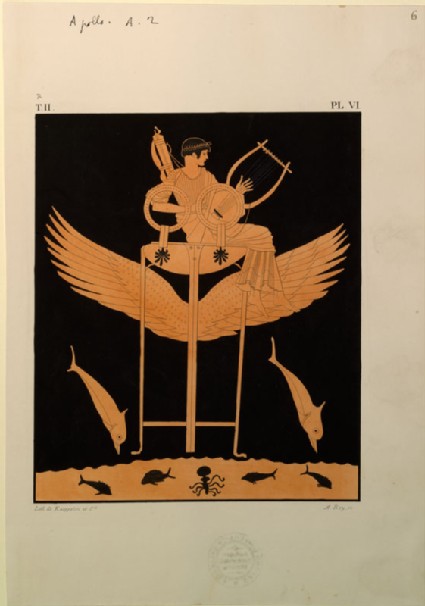Browse: 1470 objects
- Reference URL
Actions
Print of the Decoration on a Greek Hydria, showing Apollo Kaeppelin et Compagnie
-
Curator’s description:
Description
The lithograph shows Apollo in the centre, holding his lyre, seated on the Delphic tripod, with a pair of wings behind it. A dolphin is shown to either side of the tripod, and below is the sea with several fish and an octopus. The print reproduces the decoration of a red-figure hydria in the Museo Gregoriano in Rome. It was plate VI in the second volume of Lenormant and de Witte's "Elite des monuments céramographiques", published in 1857. It was presumably taken from Ruskin's copy of the work now preserved in the Ruskin Library (inventory no. 1996B2621), which is missing many of its plates.
The print was first catalogued by Ruskin in 1870, as no. 207 in the Standard Series, framed with another print from Lenormant and de Witte of a black-figure illustration of Apollo and two women; they formed part of a series 'arranged chiefly with the view of showing the change in Greek conception of deity'. It retained its number in the 1871 catalogue of the Standard and Reference Series but, by the time Cook and Wedderburn were compiling their edition of the catalogues (published in 1906), the frame had been moved to no. 189. Cook and Wedderburn note (XXI.45 n. 1) that it carried its original number (207) on the edge of its frame, but the new number (189) on the face. Presumably, it was easier to engrave and attach a new ivory label on the edge of the frame than it was to remove or gild over the painted number on the face.
According to Ruskin, the change in the ancient Greek conception of deity took place between the sixth and fourth centuries BC, and was marked by a development from conceiving of the gods as embodiments of physical forces to individual, characterised intelligences; from active to passive figures; and from grotesque to deliberately-selected beautiful depictions. At the same time, ceramic decoration changed from painting black figures on the red ground to painting a black background, letting the red ground show through in the figures themselves - though this soon led to careless execution. He believed the best vases were red-figure vases produced just after the transition (Catalogue of Examples, pp. 25-27; Standard and Reference catalogue, pp. 28-30).
Ruskin described the print as showing 'The Delphic Apollo crossing the sea'. However, discussing the frame in his lecture on "Light" on 16 March 1870, Ruskin concentrated on the print above it in the frame, pausing to note only 'Underneath, Artemis, and Apollo, of Phidian time' (Lectures on Art, § 154 = XX.148). Talking of the motion of dolphins in "The Queen of the Air", he noted how 'the dolphin’s arching rise and re-plunge ... [is] taken as a type of the emergence of the sun or stars from the sea in the east and plunging beneath in the west. Hence, Apollo, when in his personal power he crosses the sea, leading his Cretan colonists to Pytho, takes the form of a dolphin, becomes Apollo Delphinius, and names the founded colony "Delphi." The lovely drawing of the Delphic Apollo on the hydria of the Vatican ..., gives the entire conception of this myth' (§ 39 = XIX.337). The image was reproduced as plate XV in Cook and Wedderburn's edition of "The Queen of the Air" (XIX, pl. XV, f.p. 338).
-
Details
- Artist/maker
-
Kaeppelin et Compagnie (active c. 1839 - c. 1860) (printer)A. Rey (active c. 1844 - c. 1858) (lithographer)
- Object type
- Material and technique
- watercolour and bodycolour over lithograph on wove paper
- Dimensions
- 227 x 191 mm (stone); 351 x 244 mm (sheet)
- Inscription
- Recto, all printed, around the image:
top left: T.II.
top right: PL. VI.
bottom left: Lith. de Kaeppelin et Cie.
bottom right: A. Rey, sc.
Recto, in manuscript, all in ink:
top, towards left: Apollo. A.2
just above the top left corner of the image: R
Verso, bottom centre, the Ruskin School's stamp
- Provenance
-
Presented by John Ruskin to the Ruskin Drawing School (University of Oxford), 1875; transferred from the Ruskin Drawing School to the Ashmolean Museum, c.1949.
- No. of items
- 1
- Accession no.
- WA.RS.REF.189.b
-
Subject terms allocated by curators:
Subjects
-
References in which this object is cited include:
References
Ruskin, John, Catalogue of Examples Arranged for Elementary Study in the University Galleries (Oxford: Clarendon Press, 1870), cat. Standard no. 207
Lenormant, Charles, and Jean de Witte, Elite des monuments céramographiques: Matériaux pour l'histoire des religions et des moeurs de l'antiquité, 4 vols in 8 (Paris: Leleux, 1844-1861), vol. II, pl. VI
Ruskin, John, Catalogue of the Reference Series Including Temporarily the First Section of the Standard Series (London: Smith, Elder, [1872]), cat. Reference no. 207
Ruskin, John, ‘The Ruskin Art Collection at Oxford: Catalogues, Notes and Instructions’, Edward T. Cook and Alexander Wedderburn, eds, The Works of John Ruskin: Library Edition, 39 (London: George Allen, 1903-1912), 21, cat. Reference no. 189
Ruskin, John, ‘Lectures on Art: Delivered Before the University of Oxford in Hilary Term, 1870’, Edward T. Cook and Alexander Wedderburn, eds, The Works of John Ruskin: Library Edition, 39 (London: George Allen, 1903-1912), 20
Ruskin, John, ‘The Queen of the Air: Being a Study of the Greek Myths of Cloud and Storm’, Edward T. Cook and Alexander Wedderburn, eds, The Works of John Ruskin: Library Edition, 39 (London: George Allen, 1903-1912), 19
Location
-
- Western Art Print Room
Position in Ruskin’s Collection
Ruskin's Catalogues
-
Ruskin's Catalogue of Examples (1870)
Beneath, The Delphic Apollo crossing the sea. -
Ruskin's Standard & Reference series (1872)
Beneath, the Delphic Apollo crossing the sea .





